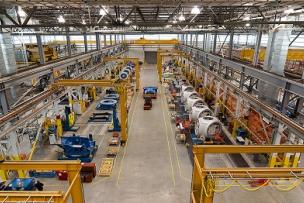Less than a year old, this state-of-the-art tooling and fabricating plant is pushing the envelope in transportation innovation.
In the large new facility billed as the world’s first Hyperloop factory, manufacturing professionals are working to turn billionaire engineer and inventor Elon Musk’s high-speed, futuristic transportation dream into a reality.
Musk, CEO of Tesla Motors, unveiled the Hyperloop concept in 2013. A prototype is in the works in the Nevada desert. The developer, Los Angeles-based Hyperloop One, aims to use electric propulsion and magnetic levitation to move a pod containing passengers and cargo through a tube in a near-vacuum environment. Floating slightly above a track, the pod would cover long distances at speeds comparable to those of airliners. In an agreement with the United Arab Emirates, the feasibility of building the first Hyperloop system is being studied. The system would allow, for example, travel from Dubai to Abu Dhabi in 12 minutes, a 97-mile trip that is a two-hour drive today.
A Cutting-Edge Metalworking Facility
The venue for much of the work is Hyperloop One Metalworks, a 105,000-square-foot fabrication plant in North Las Vegas. Inside, engineers, technicians, machinists and welders are building and testing components for DevLoop (Development Hyperloop), the Hyperloop prototype, scheduled to be tested this year. The goal is to safely achieve speeds of up to 700 mph. Hyperloop One Metalworks also houses new CNC mills, lathes and welding machines, as well as a modern metrology room where DevLoop materials and components are measured in a controlled environment.
Wayne Rapp, Hyperloop One’s director of manufacturing, describes the facility as “a very traditional machine shop” planned specifically to develop and build DevLoop hardware. Roughly the size of two football fields, Hyperloop One Metalworks is big enough to accommodate the large pieces of DevLoop hardware under construction and the large tools used to make it. The facility also gives Rapp and his staff room to expand.
“We are primarily looking for experienced machinists, fabrication specialists and tooling specialists,” says Rapp, who currently has a staff of about 30. “But we also have room for younger hires who are learning their trade.”
Key equipment includes waterjet cutters from Flow International Corp., which use high-pressure water to cut steel sheets at speeds up to 36 meters per minute and with accuracy of up to 0.025 mm/m. The team also has at its disposal three Haas CNC machine tools, a Blanchard grinder and plenty of MIG and TIG welding gear.
Getting Production Right the First Time
Considering the manufacturing capabilities assembled at Hyperloop One Metalworks, some may be surprised to learn that production of a crucial DevLoop component—the tube—has been outsourced. Tube production is “a fairly specialized process involving specialized gear,” Rapp explains. “For our first tube elements, we’ve chosen to go with people who know that process. Then we add a lot of value to the tube once we get it into our facility.”
Measuring about 11 feet in diameter, the steel tube is manufactured in segments. Despite the DevLoop name, plans call for the tube to be a straight structure that extends slightly more than a half-mile in length.
Parts to be produced at Hyperloop One Metalworks include the joints between tube segments, their supporting columns, and the large gate valve that will allow the Hyperloop pod to enter and exit the tube. This valve “needs to have very flat and straight surfaces so that we can get the correct sealing between the valve and valve seat,” says Rapp. “This is one of the best examples of a large welded structure that will take a fair bit of effort to get done right.”
Though Rapp is currently focused on making DevLoop a success, he’s also looking ahead to the next steps along the path to a functioning Hyperloop, including new designs that will allow faster, safer and more efficient travel. The project, which had raised $160 million in venture capital by December 2016, is predicted to transport cargo by 2019 and passengers by 2021.
What do you think about Hyperloop One’s superfast tube mode of transportation?



Talk to Us!
Seems like an interesting company and curious to see the practical application of it
29Sounds like a fabulous idea. Job creation in new technology or product is always exciting. As I am a telesales executive and work with all facets of machining and fabrication, a key concern is safety--particularly a failure in what essentially is a sealed tube. Not so much with packages or cargo but human life. I see no quick exit in the event of failure and as this is an extended tube--just curious as to this limitation. Terrific idea, nonetheless!
30This doesn't have to be a scientific vacuum. For the pressure seal, why not use a simple semi-flexible band (silicone, Teflon) held onto the door and pipe by band clamps (one clamp semi-permanent, one quick-release)?
36We've been fabricating tubes like this for decades.
Taking part in a project like this would be, "Right Up Our Alley."
30Leave a reply
Your email address will not be published. Required fields are marked *